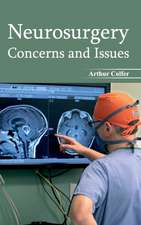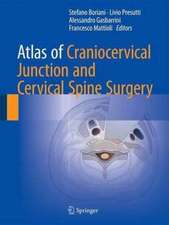Syringomyelia: Current Concepts in Pathogenesis and Management
Editat de N. Tamaki, U. Batzdorf, T. Nagashimaen Limba Engleză Paperback – 12 noi 2012
| Toate formatele și edițiile | Preț | Express |
|---|---|---|
| Paperback (1) | 714.63 lei 6-8 săpt. | |
| Springer – 12 noi 2012 | 714.63 lei 6-8 săpt. | |
| Hardback (1) | 721.56 lei 6-8 săpt. | |
| Springer – 31 iul 2001 | 721.56 lei 6-8 săpt. |
Preț: 714.63 lei
Preț vechi: 752.24 lei
-5% Nou
Puncte Express: 1072
Preț estimativ în valută:
136.76€ • 142.25$ • 112.90£
136.76€ • 142.25$ • 112.90£
Carte tipărită la comandă
Livrare economică 14-28 aprilie
Preluare comenzi: 021 569.72.76
Specificații
ISBN-13: 9784431679950
ISBN-10: 4431679952
Pagini: 276
Ilustrații: XII, 263 p.
Dimensiuni: 155 x 235 x 14 mm
Greutate: 0.39 kg
Ediția:Softcover reprint of the original 1st ed. 2001
Editura: Springer
Colecția Springer
Locul publicării:Tokyo, Japan
ISBN-10: 4431679952
Pagini: 276
Ilustrații: XII, 263 p.
Dimensiuni: 155 x 235 x 14 mm
Greutate: 0.39 kg
Ediția:Softcover reprint of the original 1st ed. 2001
Editura: Springer
Colecția Springer
Locul publicării:Tokyo, Japan
Public țintă
ResearchDescriere
Surgical skill and imaging technology in the field of neurosurgery have developed remarkably during the past decade. Magnetic resonance imaging (MRI), with high contrast resolution and multiplanar capabilities, allows for accurate preoperative localization and postoperative assessment of syringomyelia. Recent advances in dynamic MRI techniques have made it possible to evaluate normal and abnormal cerebrospinal fluid (CSF) flow at the foramen magnum, within the syrinx, and in the spinal subarachnoid space, without invasion of the closed CSF system. These developments have yielded substantial information concerning various aspects of syringomyelia. However, many issues related to the pathophysiology and treatment of syringomyelia remain controversial. This book contains the scientific contributions presented at the international sym posium "Syringomyelia 2000:' held in Kobe, Japan, June 16-17,2000. The purpose of the symposium was to bring together experts in the fields of neurosurgery, neurol ogy, and neuropathology, in order to enhance the level and scope of their knowledge by making them more aware of work done in complementary fields. The contribu tions also report on clinical and basic studies pertinent to the topic of the sympo sium. This volume thus represents a comprehensive description of the state of the art regarding this disease in the hope that it may help to define comprehensively what is already known and to find new ways toward a better understanding of the patho physiology, diagnosis, and treatment of syringomyelia.
Cuprins
1. Classification and Pathology of syringomyelia: - Brief History of Syringomyelia. - Pathology, pathogenesis and classification of syringomyelia. - Age related morphological change of the human central canal of the spinal cord and the mechanism of syrinx formation in syringomyelia and hydromyelia. 2. Experimental studies: - Histological and MRI study on experimental syringomyelia. - Histological evaluation for mechanism of syrinx formation in rats experimental models with injury and secondary adhesive arachnoiditis. - The pathogenesis of syringomyelia in an experimental model of chronic tonsillar herniation; Studied by intraventricular injection of WGA-HRP. - Biomechanical changes of the spinal cord caused by Chiari I malformation. - Physical analysis of CFS dynamics in the Spine. 3. Pathophysiology of syringomyelia: - Hydrodynamics of syringomyelia. - Intraoperative ultrasonography during foramen magnum decompression for syringomyelia associated with Chiari Type-I malformation. - Intraoperative CFS findings to predict result of syringomyelia of Chiari Type I Malformation. - Quantitative analysis of cerebrospinal fluid flow dynamics in syringomyelia with use of Two-dimensional phase contrast images . - Deep pain loss in syringomyelia and other spinal cord lesions. - Some further thoughts on the etio-pathology of syringomyelia associated with foramen magnum abnormality. 4. Syringomyelia associated with abnormalities of craniocervical junction: - Treatment of syringomyelia associated with Chiari I malformation. - Craniovertebral junction abnormalities with hindbrain herniation and syringomyelia: Regression of syringomyelia after excision of ventral craniovertebral compression. - T-tube syringoperitoneal shunts for the treatment of syringomyelia associated with Chiari I malformation. - Diagnosis and treatment of syringomyelia (SM) from 170 cases personal experience. - Simple expansive suboccipital cranioplasty following foramen magnum decompression for the treatment of syringomyelia associated with Chiari malformation. - Surgical treatment of syringomyelia associated with Chiari I malformation: foramen magnum decompression and syringo-subarachnoid shunting. - Surgical results of two types of foramen magnum decompression for syringomyelia. - Operative results of syringomyelia with special reference to reoperated cases. - Variation of the foramen magnum decompression for the treatment of syringomyelia determined by intraoperative CSF flow dynamics study. - Surgical treatment of syringomyelia associated with Chiari I malformation - Advantage of cranioplasty with hydroxyapatite. - Intractable syringomyelia : Study of reoperation cases. 5. Syringomyelia associated with Chiari II malformation: - Treatment of syringomyelia associated with Chiari Type II malformation. - Spectrum and treatment of neonatal syringomyelia with myelomeningocele. 6. Syringomyelia associated with tethered cord and other disorders: - Syringomyelia Associated with Tethered Cord Syndrome. - Surgical management of syringomyelia with craniosynostosis. - Pathophysiology and treatment of syringomyelia associated with tuberculous meningitis.
Caracteristici
Provides valuable state-of-the-art information for professionals in the fields of neurosurgery, neurology, and neuropathology and for all others concerned with syringomyelia















